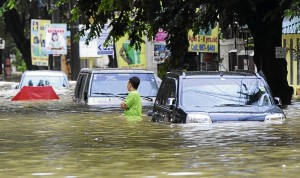PH among Asian economies ‘most at risk’ from natural disasters

A man stands next to submerged vehicles parked along a flooded street in suburban Manila on August 8, 2012, as the capital city battled deadly floods for a second day. AFP FILE PHOTO
PARIS – Asian countries dominate a league table of economies most at risk from earthquakes, floods, storms and other natural hazards, according to research published on Wednesday.
In an assessment of 197 countries, British risk consultancy Maplecroft said six Asian countries were among the 10 countries whose economies were most vulnerable to catastrophes.
The list is headed by Bangladesh and the Philippines, which along with Myanmar are considered to be at “extreme” risk.
Only one other country, the Caribbean state of Dominican Republic, falls into this category, and was rated third overall.
The other countries in the top 10 were India, Vietnam, Honduras, Laos, Haiti and Nicaragua.
The “Nature Hazards Risk Atlas” looks at the impact of natural disasters on a country relative to its economy, taking into account preparedness to deal with such events and social ability to rebound.
If a country’s infrastructure is weak and its governance is poor, the economic consequences are that much greater.
The report highlighted the impact on the Philippine economy from storms, landslides, volcanoes and floods, including severe flooding that struck the northern island of Luzon last week.
It also noted the consequences of drought in India, which this year is likely to shave 0.5 percent off the country’s gross domestic product (GDP).
The analysis’s other benchmark is the absolute exposure to natural hazards, meaning the total bill from a disaster. This is different from relative exposure, which means the economic pain that comes from it.
By the “absolute” yardstick, the countries that face the biggest tabs when natural catastrophes occur are Japan, the United States, China, Taiwan and Mexico.
However, they have greater muscle and stronger institutional means to cope, and this limits the hit to the economy.
“As the global influence of emerging economies increases, the importance of their inherent natural hazard exposure will have wider and deeper global implications,” said Maplecroft analyst Helen Hodge.
“The test for emerging and developing economies is to build a stronger capacity to meet the challenge of hazard-prone environments. Failure to do so will risk their ambitious economic growth when the inevitable natural hazards strike.”
According to the reinsurance giant Munich Re, 2011 was the costliest year ever for natural disasters, inflicting economic losses of $380 billion. The March 11 2011 earthquake and tsunami accounted for 55 percent of the total.